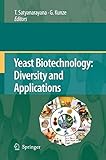Yeast Biotechnology: Diversity and Applications / edited by T. Satyanarayana, Gotthard Kunze.
Tipo de material: TextoEditor: Dordrecht : Springer Netherlands, 2009Descripción: xxI, 744 páginas recurso en líneaTipo de contenido:
TextoEditor: Dordrecht : Springer Netherlands, 2009Descripción: xxI, 744 páginas recurso en líneaTipo de contenido: - texto
- computadora
- recurso en línea
- 9781402082924
- TP248.13-248.65
Springer eBooks
Diversity and Biology -- Antarctic Yeasts: Biodiversity and Potential Applications -- Basidiomycetous Yeasts: Current Status -- Hansenula polymorpha (Pichia angusta): Biology and Applications -- Debaryomyces hansenii: An Osmotolerant and Halotolerant Yeast -- Candida famata (Debaryomyces hansenii) -- Pichia guilliermondii -- Assimilation of Unusual Carbon Compounds -- Ecology and Biodiversity of Yeasts with Potential Value in Biotechnology -- Yeasts Diversity in Fermented Foods and Beverages -- Utilization of Yeasts in Biological Control Programs -- Opportunistic Pathogenic Yeasts -- Interaction Between Yeasts and Zinc -- Glutathione Production in Yeast -- The Fermentative and Aromatic Ability of Kloeckera and Hanseniaspora Yeasts -- Assimilatory Nitrate Reduction in Hansenula polymorpha -- Genetic and Molecular Insights -- Yeast Genetics and Biotechnological Applications -- A Wide-Range Integrative Expression Vector (CoMed) System for Yeasts -- Advances in Gene Expression in Non-Conventional Yeasts -- A Comparative Study of RNA Polymerase II Transcription Machinery in Yeasts -- Non-Genetic Engineering Approaches for Isolating and Generating Novel Yeasts for Industrial Applications -- Yeast Proteome Analysis -- Yeast Genomics for Bread, Beer, Biology, Bucks and Breath -- Biotechnology Applications -- Ethanol Production from Traditional and Emerging Raw Materials -- Potentiality of Yeasts in the Direct Conversion of Starchy Materials to Ethanol and Its Relevance in the New Millennium -- Thermotolerant Yeasts for Bioethanol Production Using Lignocellulosic Substrates -- Applications of the Non-Conventional Yeast Yarrowia lipolytica -- Arxula adeninivorans (Blastobotrys adeninivorans) — A Dimorphic Yeast of Great Biotechnological Potential -- Biotechnological Applications of Dimorphic Yeasts -- Extracellular Polysaccharides Produced by Yeasts and Yeast-Like Fungi -- Industrially Important Carbohydrate Degrading Enzymes from Yeasts: Pectinases, Chitinases, and ?-1,3-Glucanases -- Yeast Acid Phosphatases and Phytases: Production, Characterization and Commercial Prospects -- Nitrile Metabolizing Yeasts.
This book updates the knowledge that we have accumulated over the last couple of decades on yeast research. The yeasts are eukaryotic unicellular microfungi that are widely distributed in the natural environment, and can also be found in more specialized or extreme environments, such as low temperatures, low oxygen availabilities and water potential. Approximately 1500 species of yeasts belonging to over 100 genera have been described so far. Although the vast majority of yeasts are beneficial to human life, only a few are opportunistic human pathogens. Yeasts play an important role in the food chain, and in the carbon, nitrogen and sulphur cycles. In addition, yeasts (e.g. Saccharomyces cerevisiae, Hansenula polymorpha, Pichia pastoris) are now being used to express foreign genes for producing human proteins of pharmaceutical interest. A landmark in biotechnology was reached in 1996 with the completion of the sequencing of the entire genome of S. cerevisiae and the genome sequencing of three more yeasts (Schizosaccharomyces pombe, Candida albicans and Cryptococcus neofromans) have recently been completed. Saccharomyces cerevisiae has now become a central player in the development of an entirely new approach to biological research – systems biology. The products of modern yeast biotechnology impinges on many commercially important sectors including foods, beverages, chemicals, pharmaceuticals, industrial enzymes, agriculture and environmental bioremediation. This book is aimed at bringing together and updating the latest information on the diversity of yeasts under natural and extreme environments, their ecology and adaptations, taxonomy and systematics, physiology and biochemistry, as well as their molecular features and biotechnological applications.
Para consulta fuera de la UANL se requiere clave de acceso remoto.


